We’ve all learned the solid state drive nomenclature that Samsung uses for consumer SSDs a long time ago. The ending PRO in the name of the drive clearly says that this is a flagship product, EVO is a mass solution, and QVO is an entry-level solid-state drive. But last week the company broke the usual hierarchy – it introduced the Samsung 980, in the name of which there is no three-letter tail. And it looks like so happened because the marketing department of the South Korean manufacturer simply could not decide which class to classify the new product – the company has not yet released anything like that.
Perhaps the most logical thing for the Samsung 980 would be the end of QVO, because in fact it is an entry-level NVMe drive, the main thing in which is its low cost. But the company uses it for SSDs based on four-bit QLC 3D V-NAND memory, and Samsung 980 is a solution based on the more traditional TLC 3D V-NAND. At the same time, he is also unworthy of ending EVO, although the name 980 EVO is not yet taken. Firstly, the Samsung 980 only supports the PCIe 3.0 interface, and not the more advanced PCIe 4.0, and secondly, in this case we are talking about a drive, the characteristics of which do not allow us to classify it as an average level. The fact is that the Samsung 980 is a bufferless drive, that is, the first NVMe SSD of a South Korean manufacturer, from the design of which DRAM is removed.

If you go deeper into the past, then you can still recall the periods when Samsung released SSDs with a numerical name without any letter ending. For example, in 2015-2017, representatives of the Samsung 650 and Samsung 850 series occasionally appeared on the market. The former included bufferless drives with a SATA interface similar in design to the Samsung 980, but the latter sold full-fledged analogs of the Samsung 850 EVO of reduced capacity. In other words, the South Korean manufacturer used the “number without ending” option without any clearly expressed idea. But what was typical for both the Samsung 650 and the Samsung 850 – both the series did not last long. These were temporary proposals that were issued to solve some specific market problems, after which they were quickly retired.
The new Samsung 980 seems to have a completely different fate. This product, apparently, has come to us for a long time, because Samsung has a special mission on it. It’s not just the company’s most affordable NVMe SSD to compete with inexpensive PCIe drives like the WD Blue SN550 or Intel SSD 660p / 665p / 670p. Its main goal is that it should shift the attention of buyers who still prefer SATA drives towards solutions with an NVMe interface. After all, Samsung 980 erases the price gap between solutions with different interfaces, while offering fundamentally higher performance.
⇡ # Appearance and device
If you’ve already seen what Samsung NVMe drives look like, then the Samsung 980 is unlikely to impress you with its looks. This is a familiar black M.2 2280 PCB with chips on one side and stickers on both. The label on the front side tells the name and capacity of the drive, as well as contains technical data: article, serial number, production date and PSID-identifier for resetting the encryption password.
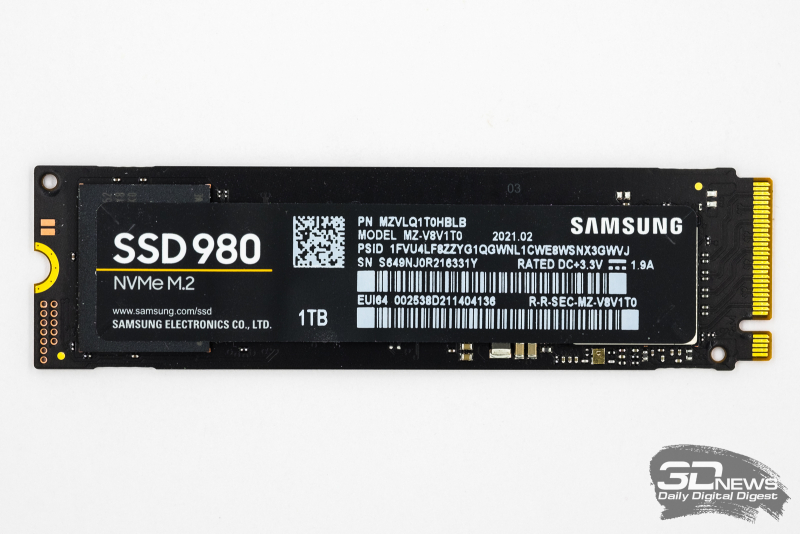
The sticker on the reverse side bears the logos of various certifications, but most importantly, it acts as a kind of radiator. A thick copper foil is laid inside it, which helps to distribute heat over the surface and remove it more efficiently.
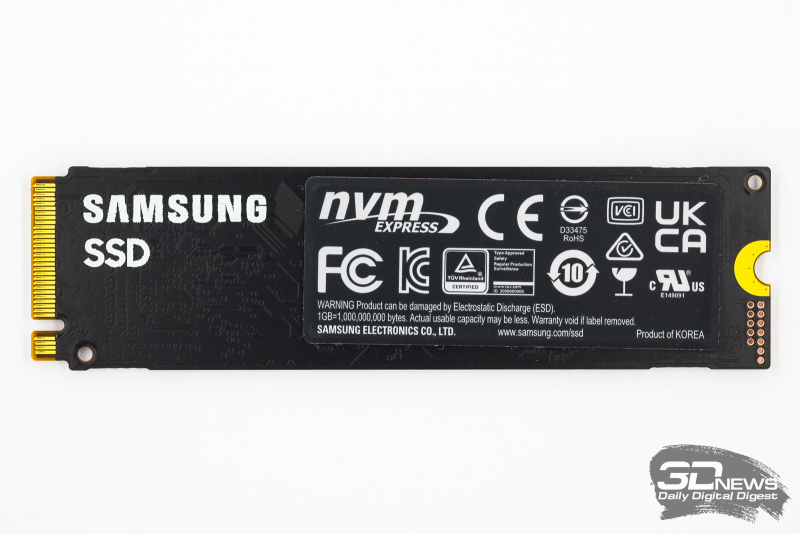
It is worth noting that the heat distribution sticker on the Samsung 980 is exactly the same as on the Samsung 980 PRO, that is, it is slightly smaller than the 970 EVO Plus and 970 PRO. Probably, Samsung thinks that the new drives heat up less than their predecessors (in fact, they don’t).
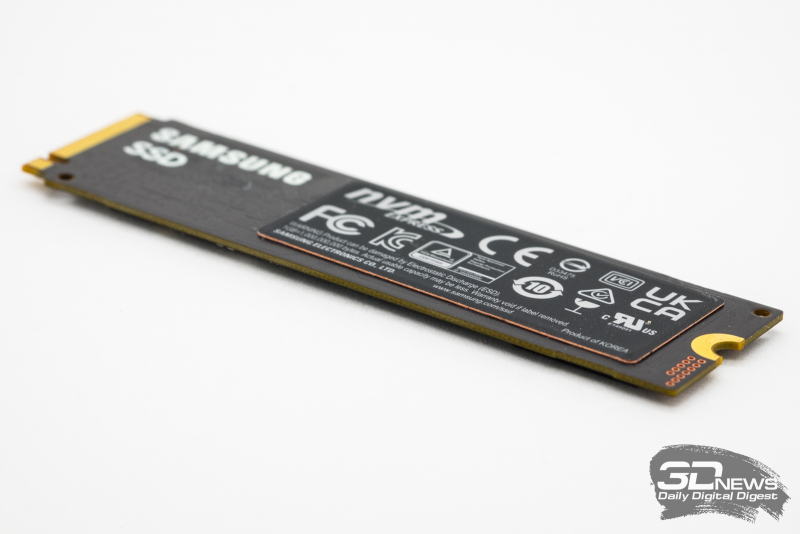
Due to the fact that the Samsung 980 does not have any protruding radiators, it can be used without problems in motherboards with their own SSD cooling systems, as well as in laptops where limited space is allocated for installing drives. Moreover, the single-sided design of the storage card allows it to be installed in thin M.2 slots found in ultrabooks.
If you remove the label from the Samsung 980, we are presented with the entire device of this drive, and it is very simple. As part of this review, we got acquainted with the 1 TB version, and this is the older version in the model range, but even in such an SSD the element base is only two microcircuits.
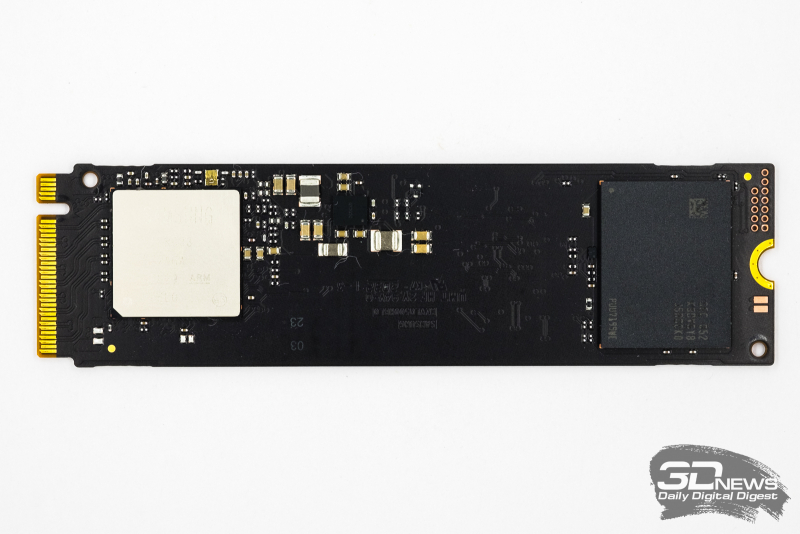
The first of the microcircuits is the Pablo controller. This is the simplest NVMe controller currently available to Samsung. It uses PCI Express 3.0 x4 to communicate with the system, and offers four channels to form a flash memory array. In addition, this controller does not provide a DRAM interface for RAM, which in performance SSD models is used to cache the address translation table. Thus, Pablo can be seen as a heavily stripped-down version of the Phoenix controller from the 970 EVO and 970 EVO Plus drives. By the way, we have already met with Pablo – it is used in the Samsung T7 external USB drive.
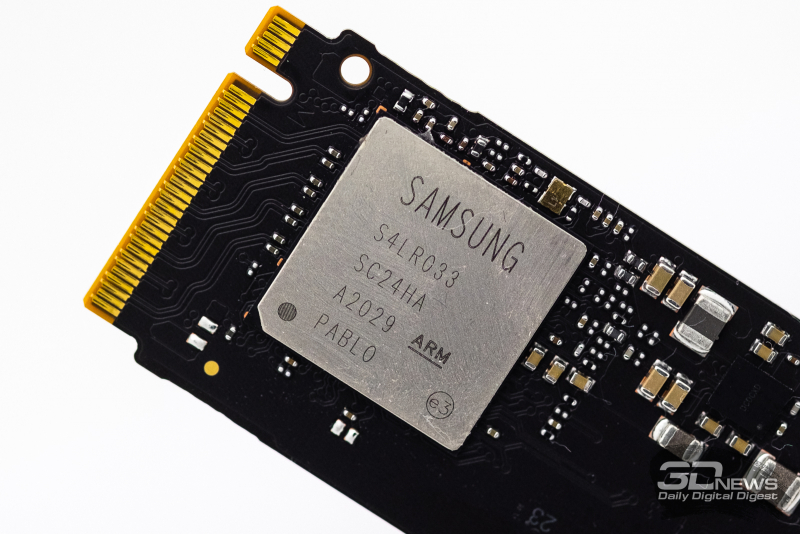
The second chip in the Samsung 980 is flash memory. In this case, almost the same 128-layer TLC 3D V-NAND of the sixth generation, as in the Samsung 980 PRO. However, in the newer and cheaper SSD, the individual NAND dice are 512 Gbps rather than 256 Gbps, which reduces the parallelism of the flash memory. For example, in a 1TB drive, the array is composed of 16 devices that are distributed across four controller channels with four interleaving. Moreover, all these 16 semiconductor crystals are packed in one single microcircuit by stacking.
In Samsung 980 versions of smaller capacities, the parallelism of the flash memory array will naturally be lower, so the best performance should be expected from the terabyte version of the drive.
⇡ # Specifications and features of work
Despite the fact that the Samsung 980 is a bufferless and inexpensive product by the standards of NVMe drives, its passport characteristics look quite grown-up. This is especially true of the older and full-fledged 1 TB version of the flash memory array – it is able to fully utilize the PCIe 3.0 x4 interface bandwidth both for reading and writing.
| Manufacturer | Samsung | ||
| Серия | 980 | ||
| Model number | MZ-V8V250BW | MZ-V8V500BW | MZ-V8V1T0BW |
| Form Factor | M.2 2280 | ||
| Interface | PCI Express 3.0 x4 – NVMe 1.4 | ||
| Capacity, GB | 250 | 500 | 1000 |
| Configuration | |||
| Flash memory: type, process technology, manufacturer | Samsung 128-layer 512-Gbps TLC 3D V-NAND | ||
| Controller | Samsung Pablo | ||
| Buffer: type, volume | No | ||
| Performance | |||
| Max. sustained sequential read speed, MB / s | 2900 | 3100 | 3500 |
| Max. sustained sequential write speed, MB / s | 1300 | 2600 | 3000 |
| Max. random read speed (4 KB blocks), IOPS | 230 000 | 400 000 | 500 000 |
| Max. random write speed (4 KB blocks), IOPS | 320 000 | 470 000 | 480 000 |
| physical characteristics | |||
| Max. power consumption, W | 3,7 | 4,3 | 4,6 |
| MTBF (mean time between failures), million hours | 1,5 | ||
| Recording resource, TB | 150 | 300 | 600 |
| Warranty period, years | 5 | ||
| Overall dimensions: D × H × D, mm | 80,15 × 22,15 × 2,38 mm | ||
| Mass, g | 9 | ||
The 980GB and 250GB versions of the Samsung 500 are noticeably slower than the terabyte modification, and this is a side effect of using large 512GB NAND devices in the flash array. Previously, in small-capacity NVMe drives, Samsung always used 256-gigabit chips, so the drop in speed characteristics seriously affected only the youngest in the lineup. version… But this is not the case with Samsung 980 – here the characteristics deteriorate steadily from the older version to the younger one.
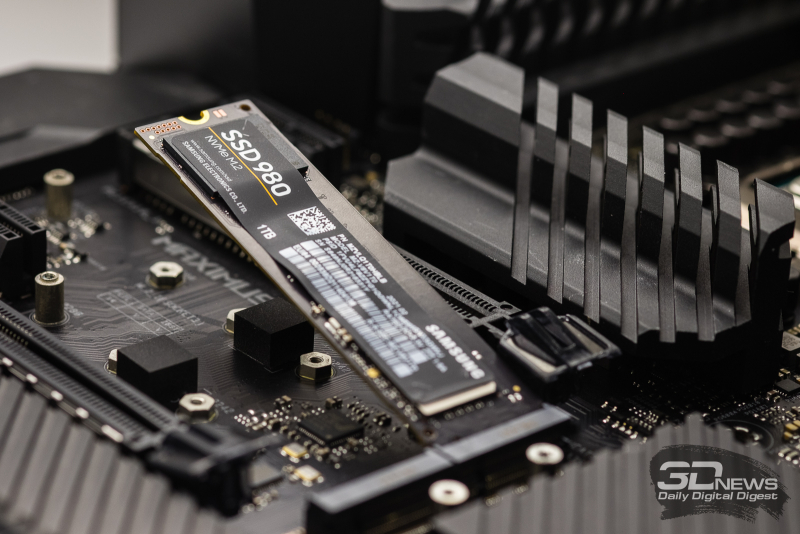
But on the other hand, if you compare the speed characteristics of Samsung’s terabyte NVMe drives, it turns out that the claimed performance of the Samsung 980 falls between the 970 EVO and the 970 EVO Plus. That is, if we talk about the most “correct” terabyte model, the Samsung 980 is quite suitable for the role of a replacement for the 970 EVO (but not the 970 EVO Plus), the supplies of which have just stopped.
| Linear Velocity | Small block speed (4KB) | |||
| Reading | Record | Reading | Record | |
| Samsung 980 PRO | Up to 7,0 GB / s | Up to 5,0 GB / s | Up to 1000 thousand IOPS | Up to 1000 thousand IOPS |
| Samsung 980 | Up to 3,5 GB / s | Up to 3,0 GB / s | Up to 500 thousand IOPS | Up to 480 thousand IOPS |
| Samsung 970 EVO Plus | Up to 3,5 GB / s | Up to 3,3 GB / s | Up to 620 thousand IOPS | Up to 560 thousand IOPS |
| Samsung 970 EVO | Up to 3,5 GB / s | Up to 2,5 GB / s | Up to 500 thousand IOPS | Up to 480 thousand IOPS |
In general, the performance of the Samsung 980 can hardly be called a compromise. Its characteristics look much better than those of any other bufferless drives. It even takes full advantage of the PCIe 3.0 x4 bus bandwidth, which is completely atypical for affordable NVMe SSDs. But at the same time, the recommended prices for the new product do not bite at all, the Samsung 980 is really an entry-level NVMe drive, which is noticeably cheaper than both the 980 PRO and the 970 EVO Plus.
| Recommended price, rub. | |||
| 250 GB | 500 GB | 1000 GB | |
| Samsung 980 PRO | 7490 | 11 990 | 18 990 |
| Samsung 970 EVO Plus | 4990 | 7990 | 14 490 |
| Samsung 980 | 4190 | 5990 | 10 990 |
However, the claimed performance of the Samsung 980 involuntarily raises a question of a different kind: how can a drive that does not have its own DRAM buffer compete so successfully with the models of previous generations that had such a buffer? And the answer to it is three letters – HMB. It is to this abbreviation that the name of the Host Memory Buffer technology is abbreviated – one of the important features that the NVMe 1.2 specification brought with it. Its essence lies in the fact that thanks to the DMA functionality of the PCIe bus, the drive controller has the ability to organize itself direct access to the computer’s RAM, which it uses instead of accessing the local DRAM buffer. In other words, the cache of the address translation table for drives with HMB support (and Samsung 980 is one of them) still exists, but it is located not locally, but in the PC’s RAM.
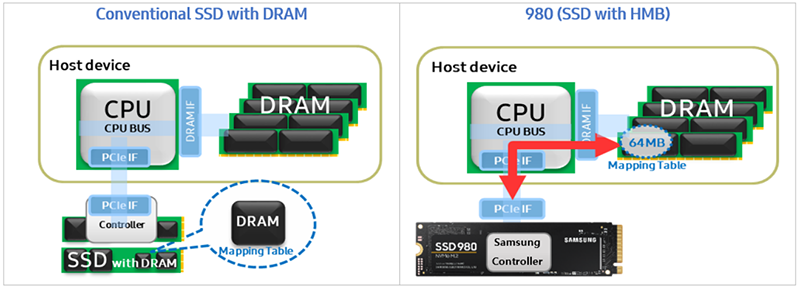
This kind of caching is a little slower because PCIe 3.0 has a lower bandwidth than 32-bit DRAM, but HMB-enabled drives do not suffer as much from this. A much more serious impact on performance can be caused by the limited amount of space that the SSD controller can capture in the computer’s RAM. For example, in the case of the Samsung 980, the size limit for this area is limited to 64 MB. This, in turn, means that only 980 GB of flash memory can be found in the Samsung 64’s Pablo controller in quick access. Access to the rest of the volume will be performed using a slow scheme through the translation table located in flash memory, but in real use it is not so easy to feel this – scenarios when you need to work with more than 64 GB of disk data simultaneously are quite rare and are more common for workstations than for mainstream personal systems.
Nevertheless, with continuous reads of large amounts of data, you can observe a twofold or even a threefold decrease in performance. This is exactly what the following graph illustrates, which shows the dependence of the speed of small-block reads on the amount of data on which these reads are performed.

In addition to HMB, the Samsung 980 also has one more technology to increase performance – Intelligent Turbo Write 2.0. This is a proprietary technology of SLC caching of write operations, which has been in all Samsung drives for a long time, but in this new product it “grew” to the second version and has changed noticeably. Previously, a combined scheme was used to allocate the SLC cache, when part of the cache was static, and the other was determined dynamically depending on the availability of free space on the SSD, now the entire cache volume is allocated exclusively dynamically. As a result, the maximum amount of flash memory operating in SLC mode and allowing fast writing has grown significantly. The maximum cache size for the terabyte version of the Samsung 980 reaches 160 GB, for the 500 GB drive – 122 GB, and for the 250 GB SSD – 45 GB.
We traditionally measured the linear write speed on the older 980TB version of Samsung 1, and found out a rather unpleasant detail. The write speed to the drive outside the SLC cache is only 400 MB / s – lower than that of solid SATA drives, for example, the same 870 EVO.
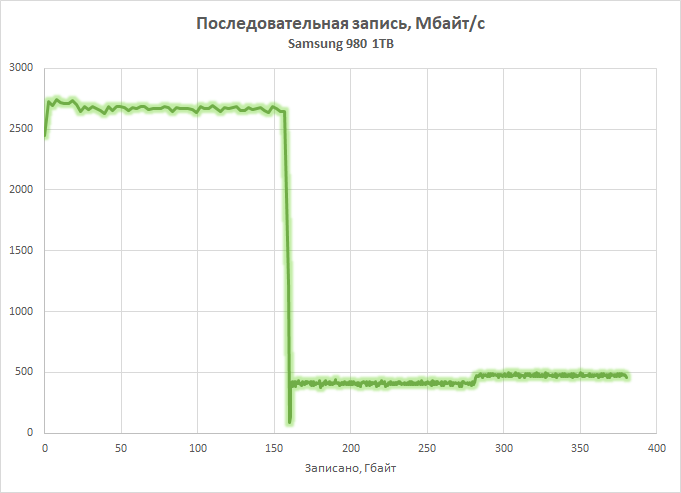
Thus, the flash memory array of the Samsung 980 in pure TLC mode writes about four times slower than that of the 980 PRO and 970 EVO Plus, and three times slower than that of the 970 EVO. But given the sufficiently large size of the SLC cache, one can hope that users will not have to deal with direct writing to TLC memory. True, owners of Samsung 980 should be advised not to fill the drive to capacity, otherwise the drop in performance can be very sensitive. For example, when 80% of the capacity of a terabyte SSD is filled, the amount of available cache is compressed to 40 GB.
The compromises don’t end there. Another nuance in the Samsung 980 concerns how it handles the TRIM command. The Pablo controller does not have as high computing power as Phoenix or Elpis, a four-channel flash memory array assembled from 512 Gbit chips does not have a very high access speed, and the lack of a fast buffer of sufficient size does not allow you to quickly find the necessary flash pages. In sum, this leads to the fact that after deleting large files or directories, the drive goes into a stupor for a few seconds. The following graph shows the performance of a small block read immediately after erasing a total of 64GB files on an SSD.
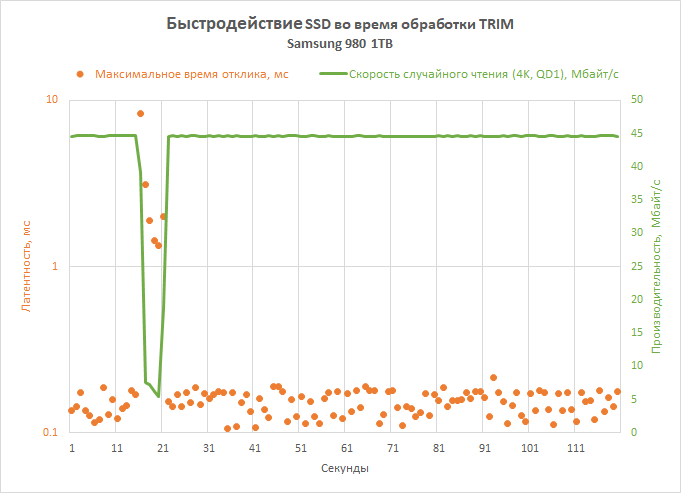
The garbage collection operation required after deleting the files in our example takes up to 6 seconds. During this time, SSD performance drops by an order of magnitude, and delays in accessing data increase on a similar scale. This is fundamentally at odds with how TRIM is processed in the same 980 PRO – there is no slowdown at all.
However, the Samsung 980 also has obvious trump cards. In particular, its low price did not affect the terms of the warranty in any way: its term is the same 5 years as that of the flagship 980 PRO. Moreover, the use of a similar sixth generation TLC 980D V-NAND at the heart of the Samsung 3 allows the manufacturer to declare exactly the same resource as the older models: a novelty can be rewritten up to 600 times during its life.
⇡ # Software
Samsung offers a special service utility Magician for its solid-state drives, which is constantly evolving and has already grown to version 6.3. We have repeatedly written about its capabilities, and therefore it makes no sense to describe all the functions in detail. The main thing: this utility provides the user with a complete set of diagnostic information, and also allows you to check the performance and status of the flash memory of the drive.
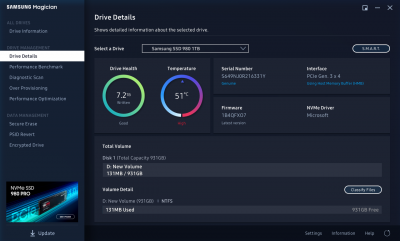 |
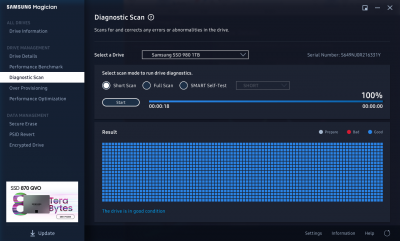 |
In addition, Magician allows you to maintain the drive: increase the size of the spare area, enable or disable TRIM support, perform the Secure Erase operation, enable hardware encryption of information on the SSD using the AES-256 algorithm, and update the firmware if necessary.
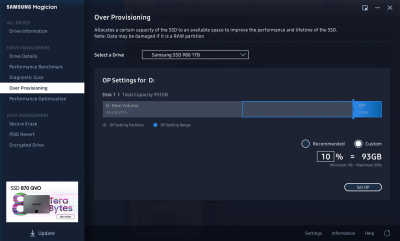 |
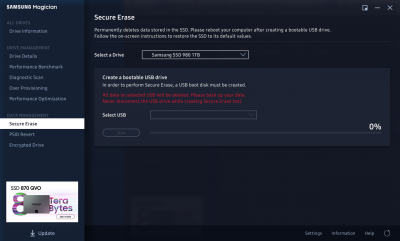 |
The latest versions of Magician have a handy desktop widget that allows you to monitor the status and activity of your drive in real time.
 |
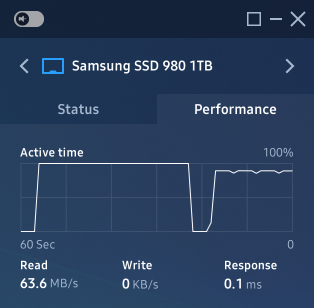 |
But the most interesting thing is the new Full Power Mode feature, which is introduced in the new version of Magician 6.3. It allows you to slightly increase the performance of the SSD by disabling all power-saving modes defined for PCIe devices. On the one hand, this leads to an increase in consumption and temperatures, since the SSD controller is always in an active state. But on the other hand, it reduces latencies, and with small-block operations, you can really get a few percent additional performance.
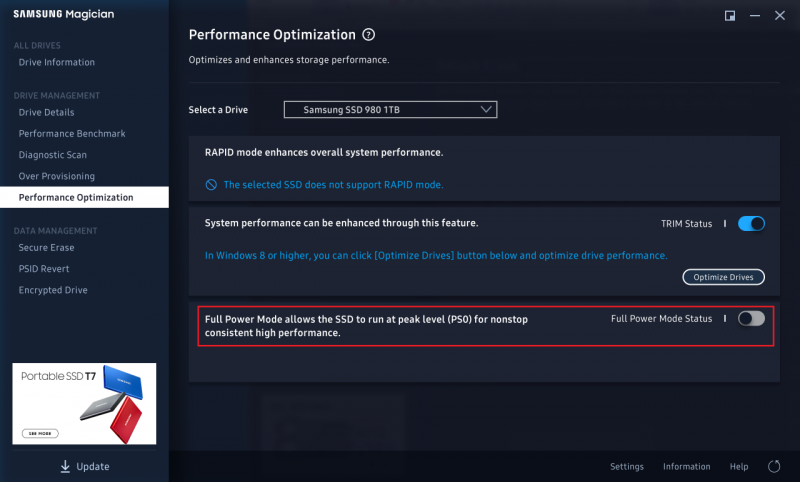
Game Mode, similar in effect, has long been implemented in Western Digital drives. Apparently, Samsung engineers also liked the ability to block power management. And by the way, this function is available not only for Samsung 980, it can also be activated for Samsung 980 PRO. However, the older 970 EVO and 970 EVO Plus drives do not support Full Power Mode.
⇡ # Description of the test system and testing methodology
Samsung is positioning the novelty under consideration today as an affordable and massive NVMe drive, the appearance of which should become an argument in favor of abandoning SATA devices. This means that the main rivals for the Samsung 980 are offerings such as the bufferless WD Blue SN550 or the QLC-based Intel SSD 660p, or numerous third-tier SSD manufacturers based on standard Phison, Silicon Motion, and the like platforms. We tried to select the most interesting competitors among them for testing, not forgetting about the “reference” Samsung 970 EVO Plus and Samsung 970 EVO.
In the end, the list of test participants turned out as follows:
- ADATA XPG Gammix S11 Pro 1024GB (AGAMMIXS11P-1TT-C, firmware 42B2S7JA);
- Corsair Force MP600 1000GB (CSSD-F1000GBMP600, firmware EGFM11.3);
- Intel SSD 660p 1024GB (SSDPEKNW010T8X1, firmware 004C);
- Samsung 970 EVO 1000GB (MZ-V7E1T0BW, firmware 2B2QEXE7);
- Samsung 970 EVO Plus 1000GB (MZ-V7S1T0BW, firmware 2B2QEXM7);
- Samsung 980 1000GB (MZ-V8V1T0BW, firmware 1B4QFXO7);
- Samsung 980 PRO 1000GB (MZ-V8P1T0BW, firmware 1B2QGXA7);
- WD Blue SN550 1000GB (WDS100T2B0C, firmware 211210WD).
In this list, the ADATA XPG Gammix S11 Pro is a standard solution based on the SM2262EN controller (this time we used a fresh version of the drive with Samsung memory in our tests), and the Corsair Force MP600 is a typical SSD based on the PCIe 4.0 Phison E16 platform.
Test system configuration:
- Processor: AMD Ryzen 7 3800X (Matisse, 8 cores + SMT, 3,9-4,5 GHz, 32 MB L3);
- CPU cooler: Noctua NH-D15;
- Motherboard: ASRock X570 Taichi (Socket AM4, AMD X570);
- Memory: 2 × 8 GB DDR4-3600 SDRAM, 16-16-16-36 (G.Skill Trident Z RGB F4-3600C16D-16GTZR).
- Video card: NVIDIA GeForce RTX 2080 Ti (TU102, 1350/14000 MHz, 11 GB GDDR6 352-bit).
- Power supply: Thermaltake Toughpower DPS G RGB 1000W Titanium (80 Plus Titanium, 1000W).
Separately, it should be clarified that the drives for tests are installed in the M.2 slot, to which PCI Express lines are connected directly from the processor.
The following benchmarks are used to measure SSD performance:
- CrystalDiskMark 7.0.0… This benchmark is included in the methodology because it was able to become the industry standard for determining the characteristics of SSDs. In our case, it is used to determine the peak performance of drives in various modes.
- Iometer 1.1.0… A professional benchmark suite that measures realistic SSD performance under common refined workloads.
- PCMark 10 Storage Benchmark… A benchmark application that measures the performance of a disk subsystem while simulating typical user experience. Three scenarios are used – basic (working in applications and normal interaction with the file system), lightweight (modeling the system disk) and file trash (modeling file storage).
- 3DNews own tests… Measuring the speed of copying files using the Robocopy utility, the speed of archiving and unzipping files with the 7-zip archiver, and the performance of disk operations when starting Far Cry 4, or when starting a series of large applications, including Microsoft Word, Adobe Photoshop and Premiere Pro.
⇡ # Performance in CrystalDiskMark
The CrystalDiskMark benchmark usually puts drives in the most favorable light, and as a rule, its indicators correspond to the numbers stated in the specifications. For the Samsung 980, all of this is done to the fullest: despite being a buffer-free drive, according to CrystalDiskMark, its performance is indeed comparable to the Samsung 970 EVO.
 |
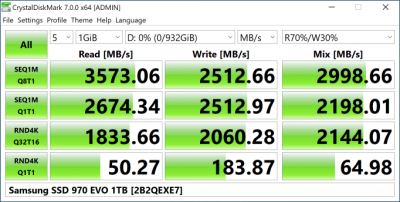 |
Moreover, the Samsung 980 even outperforms small-block out-of-order performance here.
Along the way, it would be appropriate to recall the Full Power Mode, which is activated through the Magician 6.3 utility. Enabling it can further improve the performance of the Samsung 980 in a small block load. This is how it affects the CrystalDiskMark scores.
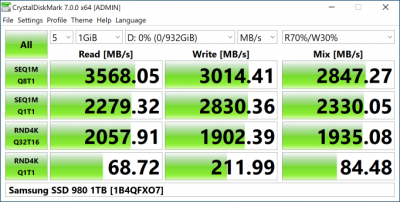
Samsung 980 1 TB – Full Power Mode
Thus, Samsung 980 users really have a magic turbo button in stock, which, at the cost of a slight increase in consumption and temperature rise, allows a little increase in the drive’s performance in synthetic benchmarks.
⇡ # Linear performance
Linear reading is the weakest point of the Samsung 980. When it comes to sequential reads with a shallow request queue, typical for personal computers, the new Samsung drive offers very low performance, outperforming most modern NVMe SSDs. This result is partly due to the unbuffered drive, and partly to the organization of its flash memory array.
However, with other linear operations, the performance situation of the Samsung 980 looks much better. So, when recording, it bypasses the entire mass of inexpensive SSDs participating in the test, including the Samsung 970 EVO. And in mixed operations, it even manages to outperform the popular ADATA XPG Gammix S11 Pro, which is considered a fairly productive model.



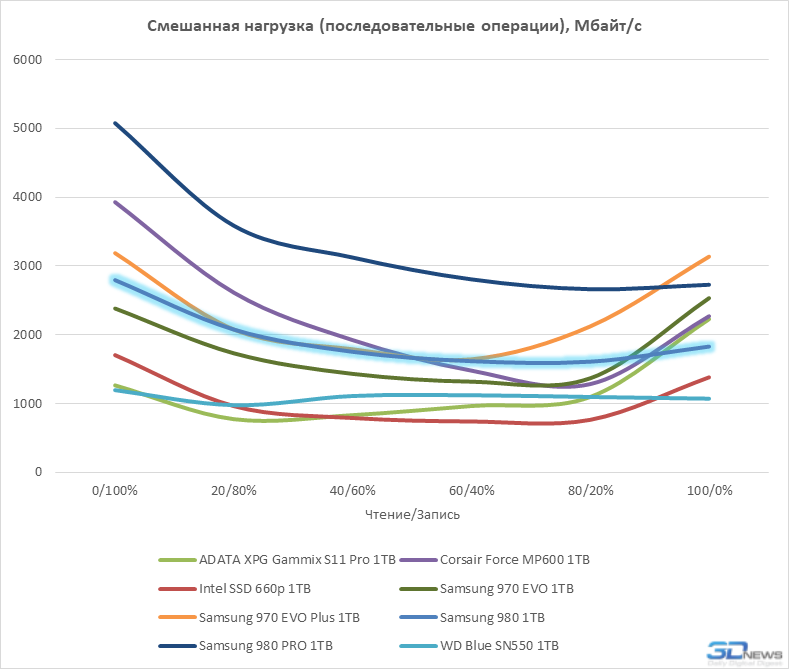
⇡ # Performance of small block operations
In casual reading, the Samsung 980’s imperfection reappears. Read operations are exactly the kind of workload in which the DRAM buffer is most actively used. Since this model does not have its own buffer, it loses, for example, to the old Samsung 970 EVO. But the relative performance of the Samsung 980 still looks good against the background of solutions from other companies. The novelty manages to bypass only the budget proposals of Intel and WD, but even a PCIe 4.0 drive based on the Phison E16 controller.
Moreover, with mixed small-block operations, the Samsung 980 climbs to the top of the chart. In this case, it turns out to be comparable in performance with the Samsung 970 EVO and bypasses not only the Corsair Force MP600 on the Phison platform, but even the ADATA XPG Gammix S11 Pro with the SM2262EN controller.
In general, synthetic tests using typical PC loads allow us to say that Samsung 980 does not look like a compromise solution at all. The HMB technology compensates well for the lack of a buffer and in some situations really allows the Samsung 980 to be perceived as a more modern analogue of the Samsung 970 EVO, which was popular in the past (but not the Samsung 970 EVO Plus).



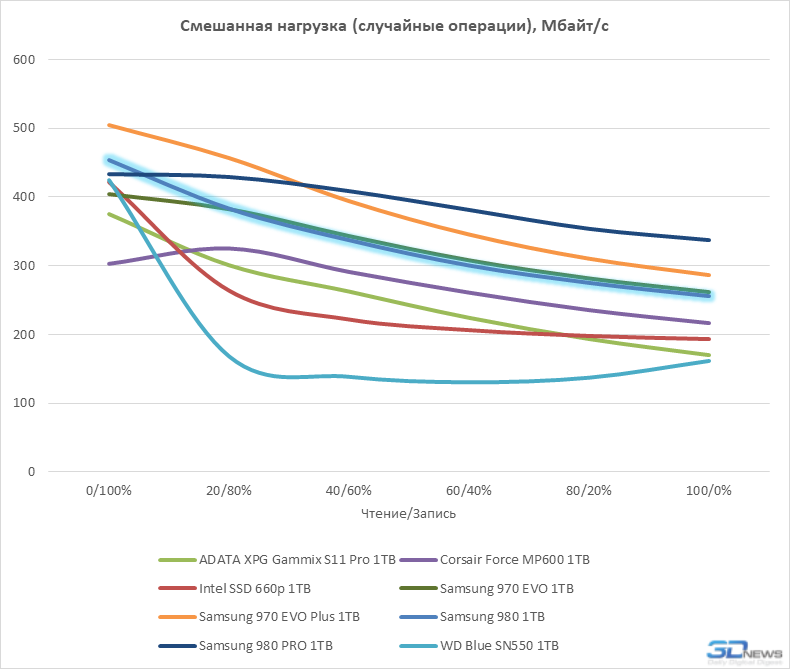
⇡ # Performance in PCMark 10
The PCMark 10 benchmark simulates various scenarios: normal multi-purpose use of a drive (Full System Drive Test), operation of an SSD as a system drive (Quick System Drive Test) and its use for storing files (Data Drive Test). The results in all three cases are not very different.
In the generalized test, the Samsung 980 manages to break into the leaderboard. This is explained by the fact that average scenarios are usually limited to working with rather small amounts of data, and in this case, HMB and Intelligent Turbo Write 2.0 technologies are able to prove themselves with maximum efficiency. The Samsung 980 also looks good as a system drive – in this case, its result is close to the performance indicator of the ADATA XPG Gammix S11 Pro and turns out to be noticeably better than that of the Samsung 970 EVO and even the Samsung 970 EVO Plus. Roughly the same can be said about the speed in the “file” scenario, although with this use Samsung 980 is still inferior to the ADATA drive.
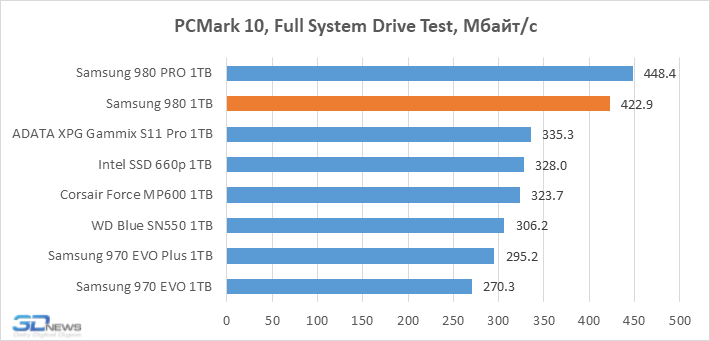

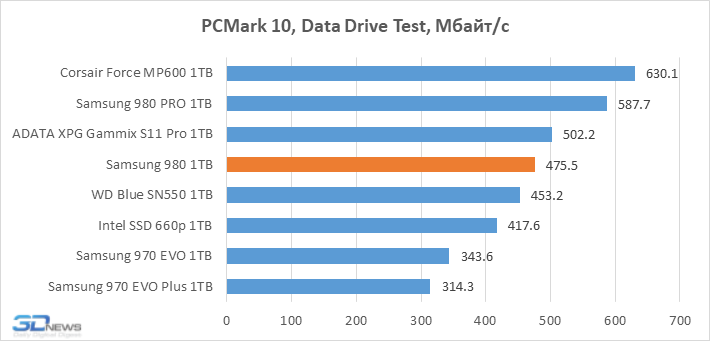
⇡ # Performance in real tasks
But the most interesting is the passing of the new Samsung 980 through our own tests, in which we perform real tasks that create a significant load on the disk subsystem. And this is where some not very pleasant details for the SSD in question come up.

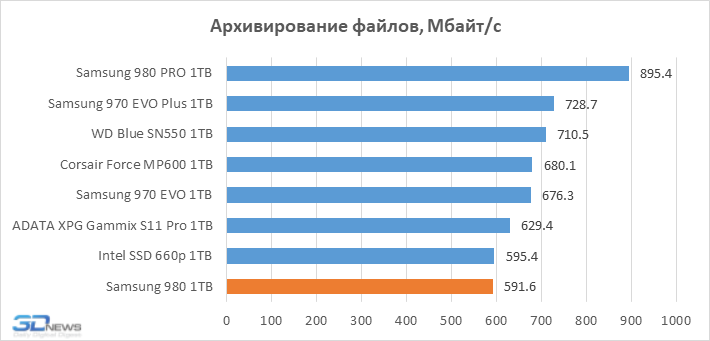
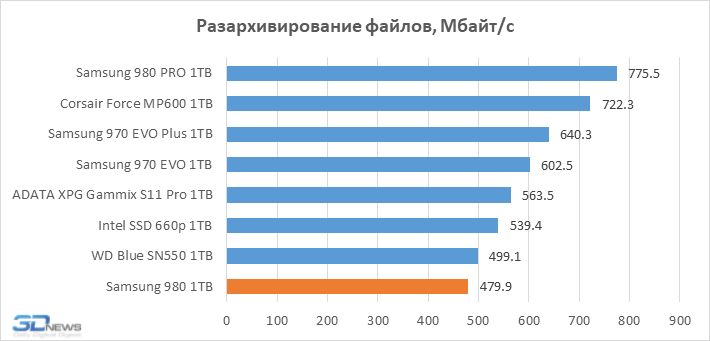
First of all, it is worth noting its low speed when copying, archiving or unzipping files. In synthetic tests, we saw that the Samsung 980 is relatively slow in sequential reads, and here this drawback turns out to be decisive. File operations inside the drive put the Samsung 980 not only below the 970 EVO, but even below the WD Blue SN550.


But as a drive for storing the operating system, programs and games Samsung 980 is very good. In such applications, it outperforms both the Samsung 970 EVO and inexpensive drives from other manufacturers, including SSDs based on the Phison E16 controller, which, by the way, has support for PCIe 4.0.
⇡ # Temperature mode
It is logical to expect low operating temperatures from a drive of the level of Samsung 980. It is not as fast as its high-performance cousins, and its Pablo controller is by no means simpler than Phoenix or Elpis.
At first glance, practice does not contradict this assumption. The temperature at which the Samsung 980 turns on throttling is 82 degrees, and a five-minute continuous load of mixed linear operations, which consist of 70% of reading, does not heat this SSD even to close values, judging by the readings of its own monitoring. The maximum heating that we were able to record in the test was 74 degrees. This means that this SSD is not threatened with a drop in performance from overheating.

But then a strange thing becomes clear. The main source of heat in the Samsung 980 is the Pablo controller, and its outer surface turns out to be much hotter than the monitoring reports. While, according to the temperature sensor, the temperature is 74 degrees, the thermal image shows the controller heating up to 95 degrees. That is, the temperature that the drive reports about itself seems to concern exclusively the flash memory.
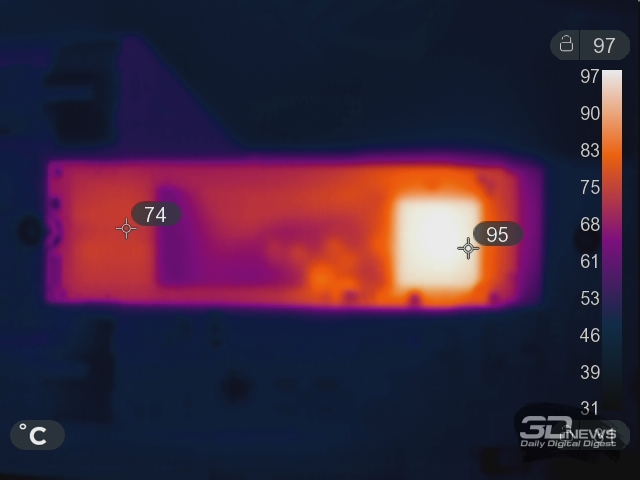
It turns out that in reality the Samsung 980 is a very hot drive that still needs either additional cooling or airflow, although Samsung for some reason tried to hide this fact. Moreover, judging by the fact that the SSD itself is guided by the memory temperature, the built-in thermal protection (proprietary Dynamic Thermal Guard technology) may not work at the right time. All this seems to be a rather dangerous approach, as a result of which Samsung 980 users may even face an SSD failure, but so far this drive has just begun to be sold, and, of course, there are no statistics on this matter yet.
⇡ # Conclusions
Samsung quite rightly chose not to call its NVMe bufferless drive the 980 EVO. The “just 980” reviewed in this review is still a lower end solution than almost any NVMe SSD with a DRAM buffer. It manifests itself immediately, as soon as there is a need to read a significant amount of information from Samsung 980 in one step. In this case, the HMB technology fails, and the drive is overwhelmed. It is for this reason that using the new product as a disk storage with fast access is clearly not a good idea.
However, the scenario described is perhaps the only scenario in which the Samsung 980 looks rather weak. If the drive is not required to give data in large portions at a time (tens of gigabytes), then its performance looks quite acceptable. In many cases, it turns out to be even faster than the outgoing Samsung 970 EVO, and therefore it is quite acceptable to consider it as a more modern replacement for this popular model. There is no doubt that Samsung has at least managed to make the best buffer-free SSD to date. Moreover, the title of the best budget NVMe drive is also applicable to the Samsung 980, since the “TLC minus DRAM” formula performed by the South Korean company is clearly better than the “QLC plus DRAM” formula used by some other manufacturers.
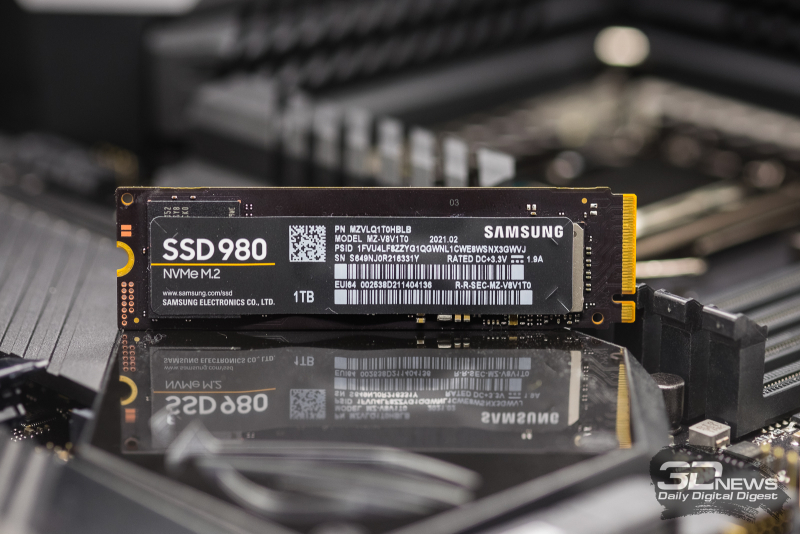
A number of side factors also play in favor of the Samsung 980. Like all other NVMe products from this manufacturer, this model is covered by a five-year warranty, which is very easy to use through a wide network of service centers. The Samsung 980 is compatible with the convenient and functional Magician service software, which continues to receive interesting new features, for example, the Full Power Mode accelerator. And to top it off, the Samsung 980 has hardware encryption support.
However, Samsung, apparently, did not at all strive to make a product that would later be called “the champion in the minor league”. The new Samsung 980 defeated inexpensive popular NVMe drives like the WD SN550 and Intel SSD 660p just in passing. In fact, the company was solving a more global problem – it was going to make such an offer to buyers of drives that could force them to reconsider their preferences and, instead of SATA drives, begin to massively purchase solutions for a high-speed and progressive NVMe interface. And in this area, Samsung is quite successful. The bufferless novelty certainly has a chance to become the final argument, which will finally push the mass adoption of the new interface, because the difference in the price of the SSD considered and, for example, the Samsung 870 EVO is only a few hundred rubles, while the model considered in this review is fundamentally superior in performance.
If you notice an error, select it with the mouse and press CTRL + ENTER.





